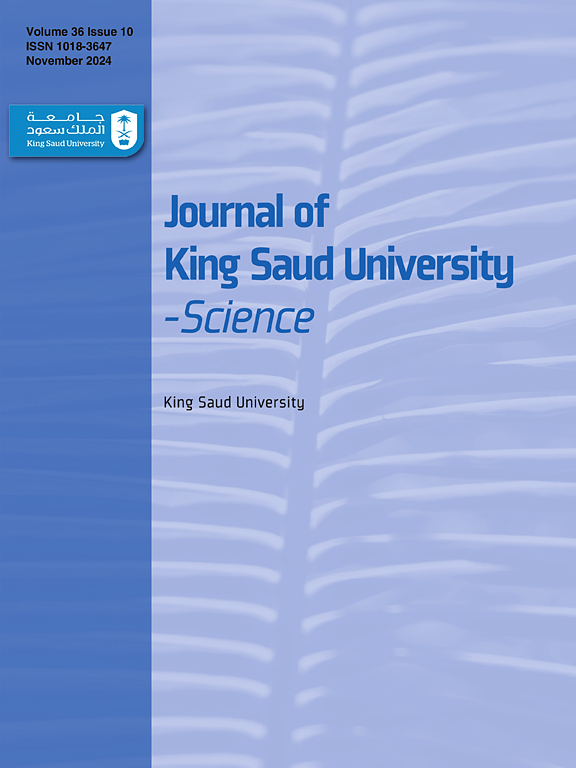Exploring the uncharted: Zinc and phosphate solubilization in Zn-P isolates from wheat rhizosphere inceptisols
IF 3.6
3区 综合性期刊
Q1 MULTIDISCIPLINARY SCIENCES
引用次数: 0
Abstract
This research delves into the untapped potential of phosphorous and zinc solubilizing rhizobacteria, known as Zn-P isolates, from wheat rhizosphere inceptisols. A total of thirty rhizosphere soil samples were collected, resulting in recovery of forty unique bacterial isolates. After initial screening, out of forty isolates, recovered on the basis of halozone formation on the nutrient agar medium. four were subjected to biochemical and further molecular identification. Four isolates, identified as Bacillus subtilis (Zn-P-1), Pseudomonas aureginosa (Zn-P-2), Staphylococcus aureus (Zn-P-3), and Methylobacterium organophyllum (Zn-P-4) through a set of 16S rRNA primers, forward (5́- GGATGAGCCCGCGGCCTA-3́) and reverse (5́- CGGTGTGTACAAGGCCCGG-3́), exhibited superior solubilization efficiency of phosphorous and zinc These strains were evaluated via in vitro and pot culture assays. The study found that Zn-P-1 demonstrated the highest zinc solubilization (134.87 mg/l) when ZnO was used as the zinc source as compared to ZnCO3 and Zn-EDTA as also highest at 72.32 mg/l in CaH2PO4 and lowest at 14.44 mg/l with KH2PO4 using P sources, thus highlighting the role of Bacillus in zinc and phosphorous activity with substrate type. The inoculation of tri-calcium phosphate (TCP) and ZnCO3, along with Bacillus and Methylobacterium, led to increased phosphorous and zinc solubilization, uptake, and use efficiency, marking these rhizobacteria as potentially beneficial for nutrient enhancement and PGPR activities in wheat crops grown in inceptisols.
探索未知领域:小麦根瘤际土壤中锌-磷分离物的锌和磷酸盐溶解作用
这项研究深入探讨了小麦根瘤菌圈浸润土中磷锌增溶根瘤菌(又称 Zn-P 分离物)尚未开发的潜力。研究人员共采集了 30 个根瘤土壤样本,从中分离出 40 个独特的细菌。经过初步筛选,根据在营养琼脂培养基上形成卤酮的情况,从 40 个分离菌株中选出 4 个进行生化鉴定和进一步的分子鉴定。通过一组 16S rRNA 引物,四个分离物被鉴定为枯草芽孢杆菌(Zn-P-1)、金黄色假单胞菌(Zn-P-2)、金黄色葡萄球菌(Zn-P-3)和有机绿叶甲基杆菌(Zn-P-4)、正向(5́- GGATGAGCCCGCGGCCTA-3́)和反向(5́- CGGTGTGTACAAGGCCCG-3́)对磷和锌的溶解效率进行了评估。研究发现,与 ZnCO3 和 Zn-EDTA 相比,当使用氧化锌作为锌源时,Zn-P-1 的锌溶解度最高(134.87 毫克/升);使用 CaH2PO4 作为磷源时,Zn-P-1 的锌溶解度最高(72.32 毫克/升);使用 KH2PO4 时,Zn-P-1 的锌溶解度最低(14.44 毫克/升)。在接种磷酸三钙(TCP)和 ZnCO3 以及芽孢杆菌和甲基芽孢杆菌后,磷和锌的溶解、吸收和利用效率均有所提高,这表明这些根瘤菌可能有益于小麦作物的养分强化和 PGPR 活性。
本文章由计算机程序翻译,如有差异,请以英文原文为准。
求助全文
约1分钟内获得全文
求助全文
来源期刊

Journal of King Saud University - Science
Multidisciplinary-Multidisciplinary
CiteScore
7.20
自引率
2.60%
发文量
642
审稿时长
49 days
期刊介绍:
Journal of King Saud University – Science is an official refereed publication of King Saud University and the publishing services is provided by Elsevier. It publishes peer-reviewed research articles in the fields of physics, astronomy, mathematics, statistics, chemistry, biochemistry, earth sciences, life and environmental sciences on the basis of scientific originality and interdisciplinary interest. It is devoted primarily to research papers but short communications, reviews and book reviews are also included. The editorial board and associated editors, composed of prominent scientists from around the world, are representative of the disciplines covered by the journal.
 求助内容:
求助内容: 应助结果提醒方式:
应助结果提醒方式:


